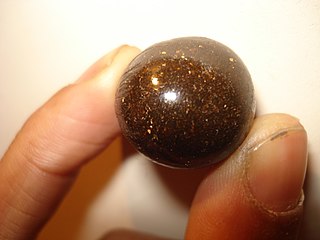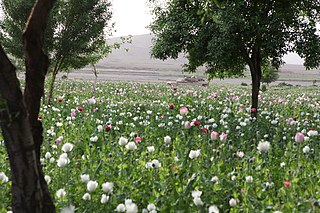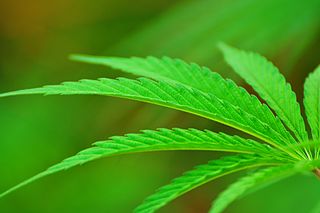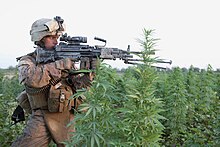
Hashish, commonly shortened to hash, is an oleoresin made by compressing and processing parts of the cannabis plant, typically focusing on flowering buds containing the most trichomes. It is consumed as a psychoactive drug by smoking, typically in a pipe, bong, vaporizer or joint, or via oral ingestion. Hash has a long history of usage in countries such as Afghanistan, Morocco, Egypt, Pakistan, India, Nepal, Iran, and Lebanon. Hash consumption is also popular in Europe. In the United States, dried flowers or concentrates are more popular, though hash has seen a rise in popularity following changes in law. Like many recreational drugs, multiple synonyms and alternative names for hash exist, and vary greatly depending on the country and native language.

The prohibition of drugs through sumptuary legislation or religious law is a common means of attempting to prevent the recreational use of certain intoxicating substances.

Narco-state is a political and economic term applied to countries where all legitimate institutions become penetrated by the power and wealth of the illegal drug trade. The term was first used to describe Bolivia following the 1980 coup of Luis García Meza which was seen to be primarily financed with the help of narcotics traffickers. Other well-known examples are Honduras, Guinea-Bissau, Mexico, Myanmar and Syria, where drug cartels produce, ship and sell drugs such as captagon, cocaine, heroin and marijuana.

Charas is a cannabis concentrate made from the resin of a live cannabis plant and is handmade in the Indian subcontinent and Jamaica. The plant grows wild throughout Northern India along the stretch of the Himalayas and is an important cash crop for the local people. The difference between charas and hashish is that hashish is made from a dead cannabis plant and charas is made from a live one.
The Golden Crescent is the name given to one of Asia's two principal areas of illicit opium production. Located at the crossroads of Central, South, and West Asia, this space covers the mountainous peripheries of Afghanistan and Pakistan, extending into eastern Iran.

Afghanistan has long had a history of opium poppy cultivation and harvest. As of 2021, Afghanistan's harvest produces more than 90% of illicit heroin globally, and more than 95% of the European supply. More land is used for opium in Afghanistan than is used for coca cultivation in Latin America. The country has been the world's leading illicit drug producer since 2001. In 2007, 93% of the non-pharmaceutical-grade opiates on the world market originated in Afghanistan. By 2019 Afghanistan still produced about 84% of the world market. This amounts to an export value of about US $4 billion, with a quarter being earned by opium farmers and the rest going to district officials, insurgents, warlords, and drug traffickers. In the seven years (1994–2000) prior to a Taliban opium ban, the Afghan farmers' share of gross income from opium was divided among 200,000 families.
The illegal drug trade in China is influenced by factors such as history, location, size, population, and current economic conditions. China has one-sixth of the world's population and a large and expanding economy. China's large land mass, close proximity to the Golden Triangle, Golden Crescent, and numerous coastal cities with large and modern port facilities make it an attractive transit center for drug traffickers. Opium has played an important role in the country's history since before the First and Second Opium Wars in the mid-19th century.

Crime in Afghanistan is present in various forms, and includes the following: corruption, contract killings or assassinations, bombings, kidnapping, drug trafficking, money laundering, black marketeering, and ordinary crimes such as theft and assault.

Spots refers to a method of smoking cannabis. Small pieces of cannabis are rolled to form the spot.

The history of smoking dates back to as early as 5000 BC in the Americas in shamanistic rituals. With the arrival of the Europeans in the 16th century, the consumption, cultivation, and trading of tobacco quickly spread. The modernization of farming equipment and manufacturing increased the availability of cigarettes following the reconstruction era in the United States. Mass production quickly expanded the scope of consumption, which grew until the scientific controversies of the 1960s, and condemnation in the 1980s.

Mohammed Daud Daud, also known as General Daud Daud, an ethnic Tajik, was the police chief in northern Afghanistan and the commander of the 303 Pamir Corps. He was an opponent of the Afghan Taliban.

Cannabis had been illegal in Morocco since the nation's independence in 1956, reaffirmed by a total ban on drugs in 1974, but was partially tolerated in the country. Cannabis has been cultivated in Morocco for centuries and the country is currently among the world's top producers of hashish. As of 2016, Morocco was the world's top supplier of cannabis. On May 26, 2021, the Moroccan parliament voted to legalize the use of cannabis for medical, as well as cosmetic and industrial purposes.

Although Cannabis use is illegal in Egypt, it is often used privately by many. Law enforcements are often particularly lax when it comes to cannabis smokers, and its use is a part of the common culture for many people in Egypt. However, Large-scale smuggling of cannabis is punishable by death, while penalties for possessing even small amounts can also be severe. Despite this, these laws are not enforced in many parts of Egypt, where cannabis is often consumed openly in local cafes.

Cannabis in France is illegal for personal use, but remains one of the most popular illegal drugs. Limited types of cannabis-derived products are permitted for medical uses.

Cannabis has been illegal in Nepal since 1976, but the country has a long history of use of cannabis for Ayurvedic medicine, intoxicant and as a holy offering for Hindu god Shiva and continues to produce cannabis illicitly.

Cannabis is illegal in Pakistan for recreational use, although since September 2020, extracts of cannabis can be used for industrial and medical use. Cannabis is widely consumed in Pakistan as charas and bhang.
The list includes and details significant events that occurred in the global history of national-level implementations of, or changes made to, laws surrounding the use, sale, or production of the psychoactive drug cannabis.
Cannabis in Mozambique is illegal; the drug is locally referred to as suruma.
Cannabis in Jordan is illegal. In 2018, Anwar Tarawneh, Director of the Anti-Narcotics Department (AND) reported that "marijuana is the most consumed drug in Jordan", with the AND seizing 1.5 tonnes of cannabis that year. As Jordan is a signatory to the 1961 United Nations Single Convention on Narcotic Drugs.

Cannabis tourism, also called marijuana tourism, is travel/tourism related to cannabis or incorporating cannabis use.

















